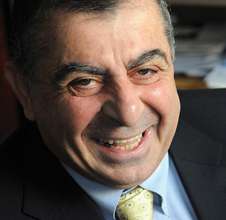3Q: As precious metals grow more precious

The value of silver soared to an all-time high last Thursday, and plunged dramatically yesterday, illustrating the constant volatility of the precious-metals market, which includes lustrous commodities like gold, silver and platinum.
Here, Kamran Dadkhah, an associate professor of econometrics and macroeconomics at Northeastern, who has studied the value of silver and gold in the foreign exchange market, discusses how the declining value of the dollar relates to the ever-shifting value of precious metals and other commodities, such as oil.
What causes the volatility of the precious-metals market?
Three factors can be counted as reasons for the sharp rise over the past year in the price of precious metals, including silver, which rose 156 percent; gold, up 34 percent; and commodities, such as oil, which climbed by 33 percent. First, the world economy has moved out of the recession. In particular, countries like China, India and Brazil have shown impressive growth and therefore, demand for commodities has been on the rise. Note that both gold and silver have industrial, medical and other uses.
The second factor is the decline of the U.S. dollar, which is the international currency. When it loses its value, the price of everything increases. A biproduct of this is an expectation of inflation. When people expect inflation, especially during times of uncertainty, they tend to rush to assets and commodities that are deemed to keep their value.
Third, the factors specific to each precious metal and commodity play a role in the market’s volatility. For example, the price of silver had historically been much lower compared to gold, and hence it is catching up. As we’ve seen, the sharp increase in the price of silver was temporary, so we should be cautious, especially as investors in silver often hedge against a decline in its value by buying options.
In the case of oil, the turmoil in the Middle East is a contributing factor, although, except for Libya, no other major producer and exporter of petroleum has had an upheaval. Nevertheless, the fear that this could affect Saudi Arabia has prompted speculation in oil.
With the U.S. dollar losing ground, will precious metals continue to climb?
There are two reasons for the decline of the dollar. Since the United States has a huge budget deficit, of necessity it has a trade deficit. This means there is an increase in the supply of the dollar compared to its demand; hence the decline in its value. Second, the Federal Reserve has been pursuing an “easy money” policy by keeping the federal funds rate close to zero. The idea is that the lower interest rate would encourage investment. Furthermore, the lower rate would cause the depreciation of the dollar, thus increasing exports and limiting imports. The dollar has declined against the yen, the Swiss franc and indeed against a broad index of foreign currencies.
It is difficult to forecast what will happen in the commodities market. Since the recession is over, we should expect a continuing upward trend in the price of commodities. However, the Fed cannot continue the current policy for long without causing severe inflation, so we should expect the increase in prices to slow down.
How does the precious-metals market in the U.S. compare to other countries?
Prices of precious metals and commodities around the world are connected. When the price of silver or gold increases in the United States, the same happens in Europe, China and other countries. The differences among countries stem from their exchange-rate policies. In a country like Saudi Arabia that pegs its currency to the dollar, the increase in the price of such commodities is one to one. If a country’s exchange rate is depreciating against the dollar, the prices of precious metals increase faster than in the United States. It is interesting to note that recently Iran’s central bank started selling a considerable amount of gold in order to stabilize its price. The action was prompted by the sharp increase in the price of gold in anticipation of a high rate of inflation and the eventual depreciation of the Iranian currency against the dollar.
Provided by Northeastern University



















